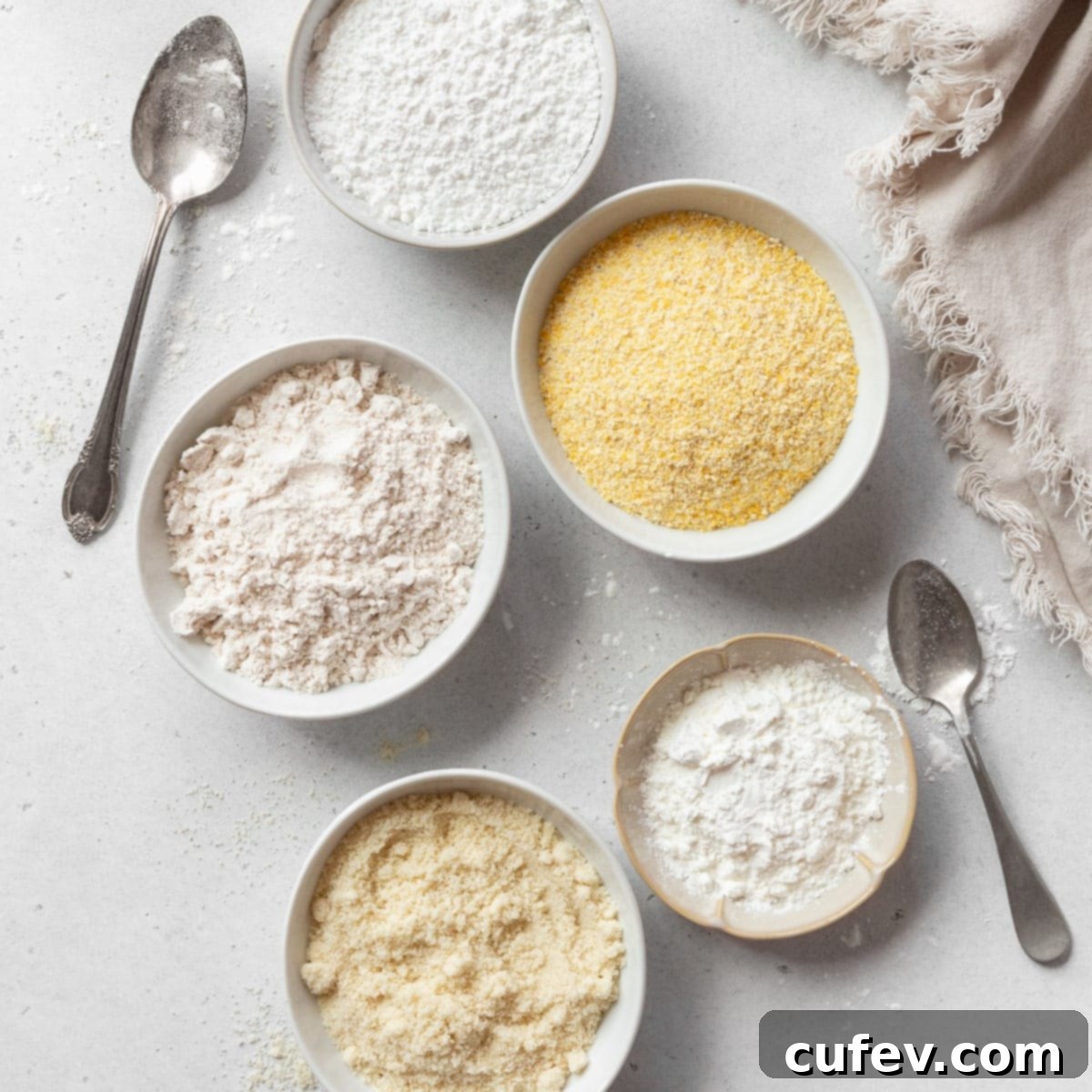Mastering Gluten-Free Baking: An Essential Guide to Gluten-Free Flours and Their Uses
Embarking on a gluten-free lifestyle, whether due to celiac disease, gluten sensitivity, or personal preference, opens up a world of new culinary possibilities. However, navigating the vast array of gluten-free flours can initially feel daunting, especially when trying to replicate the textures and flavors of traditional baked goods. This comprehensive guide is designed to demystify the most popular and effective gluten-free flours, offering insights into their unique properties, ideal applications, and how to use them to achieve delicious results in your baking.
Having personally embraced a gluten-free diet for several years, I’ve transformed countless kitchen experiments – from disappointingly crumbly cookies to delightfully chewy cakes – into valuable lessons. My journey has been one of continuous learning, adaptation, and discovery. Through this guide, my aim is to share the knowledge I’ve gained, making your gluten-free baking adventures not only easier but also incredibly rewarding and delicious. We’ll explore essential flours like almond flour, versatile rice flours, wholesome oat flour, and the convenience of gluten-free all-purpose blends, along with key starches and other specialty options.
Understanding the characteristics of each flour is key to successful gluten-free baking. Unlike wheat flour, which contains gluten that provides elasticity and structure, gluten-free flours require a different approach, often relying on blends and specific starches to mimic these qualities. Let’s dive in and unlock the secrets to creating your favorite baked treats, all completely gluten-free!
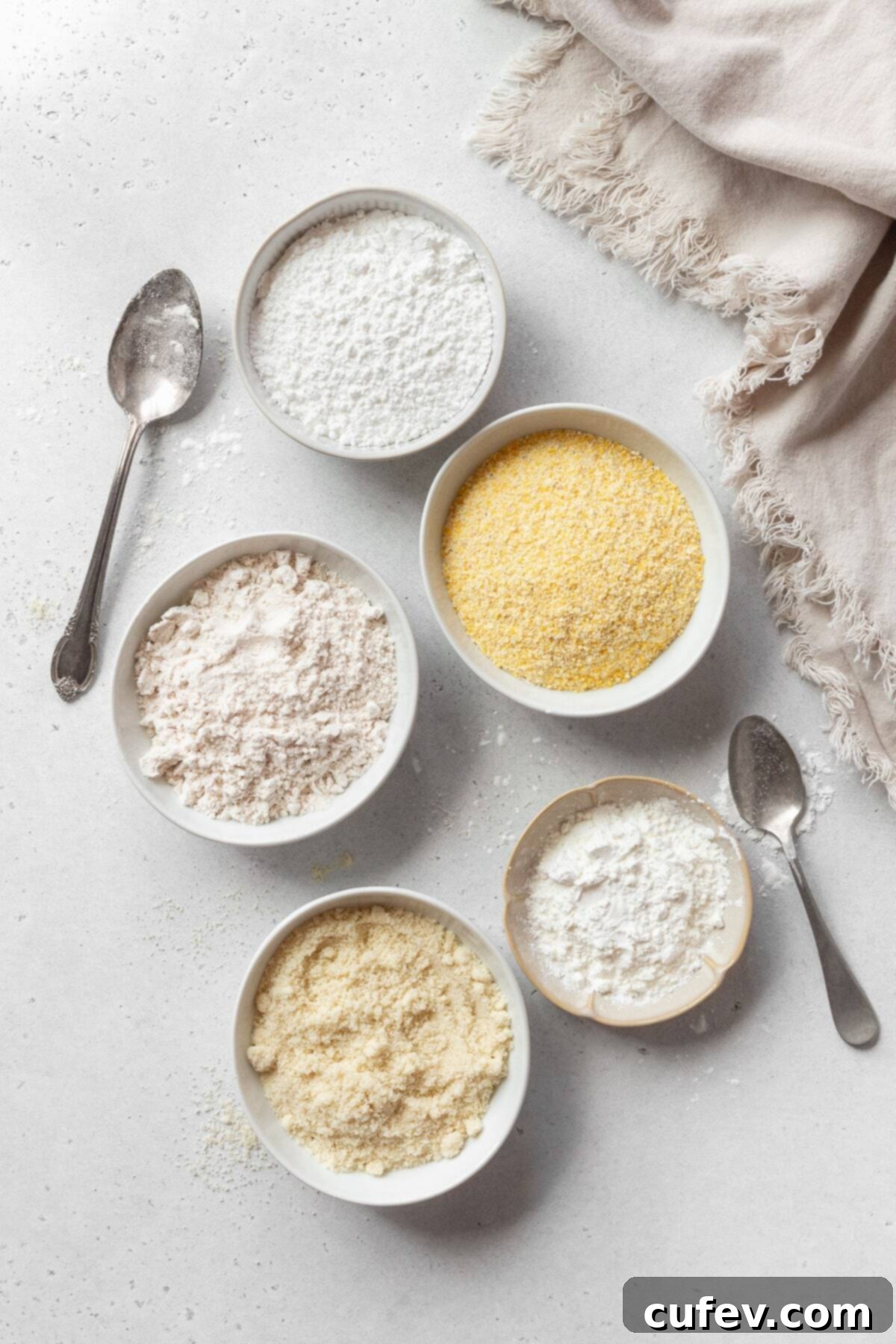
Gluten-Free Flour Blends: Your Foundation for Easy Baking
For many gluten-free bakers, especially beginners, a high-quality gluten-free all-purpose flour blend is an absolute game-changer. These expertly formulated mixes take the guesswork out of combining individual flours and starches, providing a convenient and reliable solution for a wide range of recipes. They are designed to mimic the properties of traditional wheat flour as closely as possible, making 1-to-1 substitutions often feasible in recipes specifically developed for them.
Most commercial gluten-free flour blends typically feature a base of rice flour (white or brown), combined with various starches like tapioca starch, potato starch, or cornstarch, and sometimes other flours such as sorghum or millet. This strategic combination ensures a balanced texture, flavor, and binding ability. I personally always keep a bag of Bob’s Red Mill Gluten Free 1-to-1 Baking Flour in my pantry for its consistent performance. Other excellent options include King Arthur Measure for Measure Flour and Pillsbury Gluten Free All Purpose Flour Blend, both of which deliver great results.
While many blends rely on a rice flour base, there are innovative alternatives available. For instance, brands like XO Baking Co offer blends with a cassava flour base, catering to those who prefer to avoid rice or are looking for a different textural profile. It’s always a good practice to check the ingredient list to ensure it aligns with your dietary needs and preferences.
One critical component to look for in a gluten-free flour blend is xanthan gum. Xanthan gum acts as a binder and thickener, playing a vital role in providing the structure, elasticity, and cohesion that gluten normally provides in traditional baking. If your chosen blend does not list xanthan gum as an ingredient, it is absolutely essential to add it yourself according to the recipe’s instructions (or typically about 1/4 to 1/2 teaspoon per cup of flour blend for most baked goods) to prevent your creations from becoming crumbly or dense.
Beyond standard all-purpose blends, some brands offer specialized options. For example, Cup4Cup provides a Wholesome Flour Blend, which can serve as an excellent wholewheat flour alternative, adding a richer flavor and more nutritional fiber to your gluten-free bakes. Experimenting with different blends can help you discover your favorites for various types of recipes.
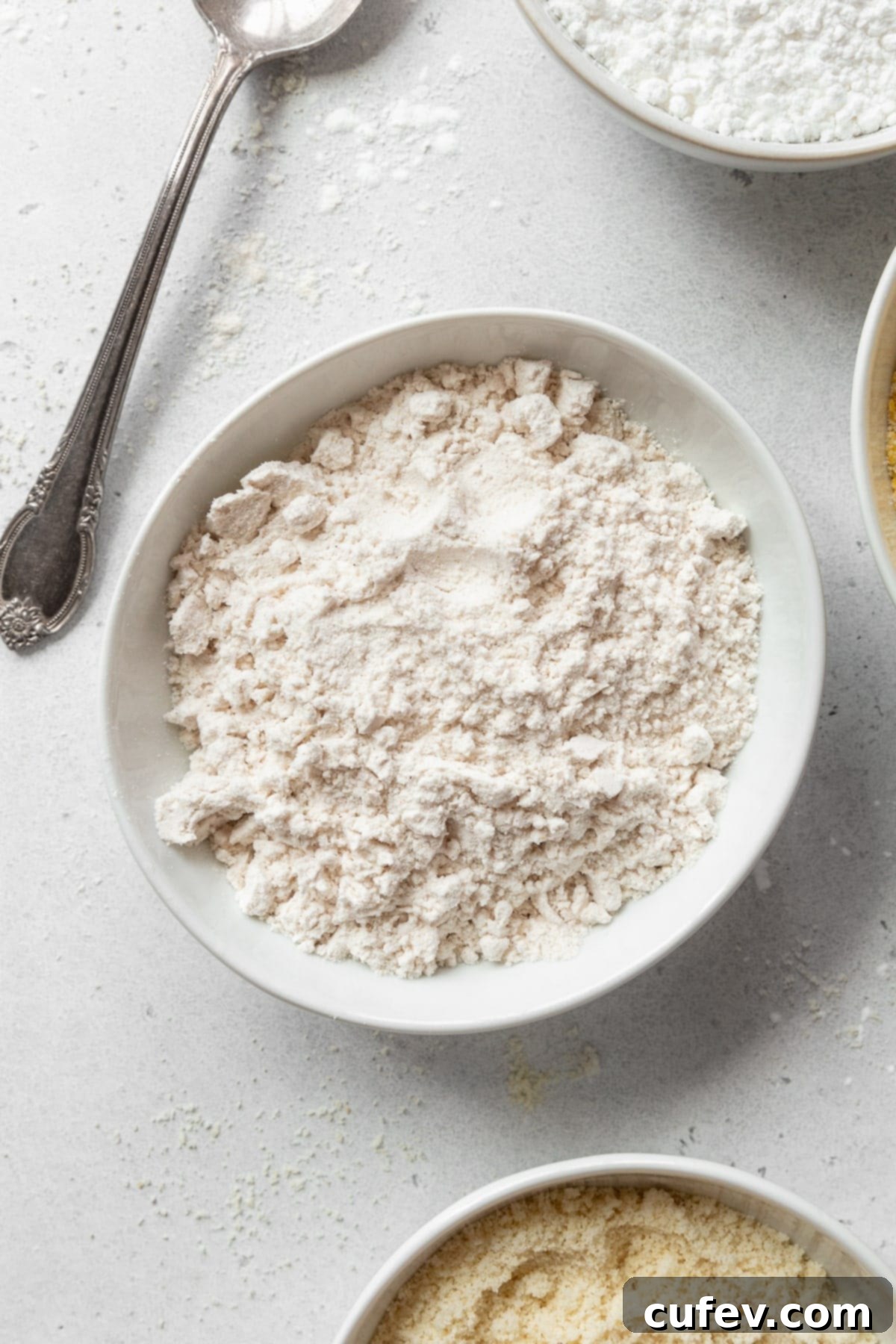
Almond Flour: Richness, Moisture, and Flavor
Almond flour is a powerhouse ingredient in gluten-free baking, celebrated for its unique ability to impart richness, moisture, and a delicate depth of flavor to baked goods. Made from finely ground blanched almonds (meaning the skins have been removed), it’s significantly different from almond meal, which is typically coarser and includes the almond skins. For most baking applications, especially those requiring a delicate texture, super fine blanched almond flour, like Bob’s Red Mill’s Super Fine Almond Flour, is the preferred choice.
What makes almond flour so exceptional? Its high fat content contributes to incredibly tender and moist results, making it an excellent choice for recipes where you want to avoid dryness. This is particularly beneficial for those following a dairy-free diet, as the natural fats in almond flour can compensate for the richness typically provided by butter or other dairy fats. It adds a subtle nutty flavor that complements both sweet and savory dishes, enhancing the overall sensory experience.
Almond flour is incredibly versatile. It can be combined with other gluten-free flours to create complex textures, as seen in my popular gluten-free pound cake and gluten-free sugar cookies, where it contributes to a tender crumb. Alternatively, it can be used as the primary or sole flour for recipes like my beloved almond flour chocolate chip cookies or moist gluten-free zucchini muffins, where its distinct properties truly shine. Due to its lack of starch, it’s often paired with starches or other flours to provide more structure.
Beyond baking, almond flour is also a fantastic coating for proteins, adding a crispy texture and delicious flavor. It’s also a low-carb, high-protein option, making it a favorite among those with specific dietary needs. Always store almond flour in an airtight container in the refrigerator or freezer to prevent it from going rancid due to its high oil content.
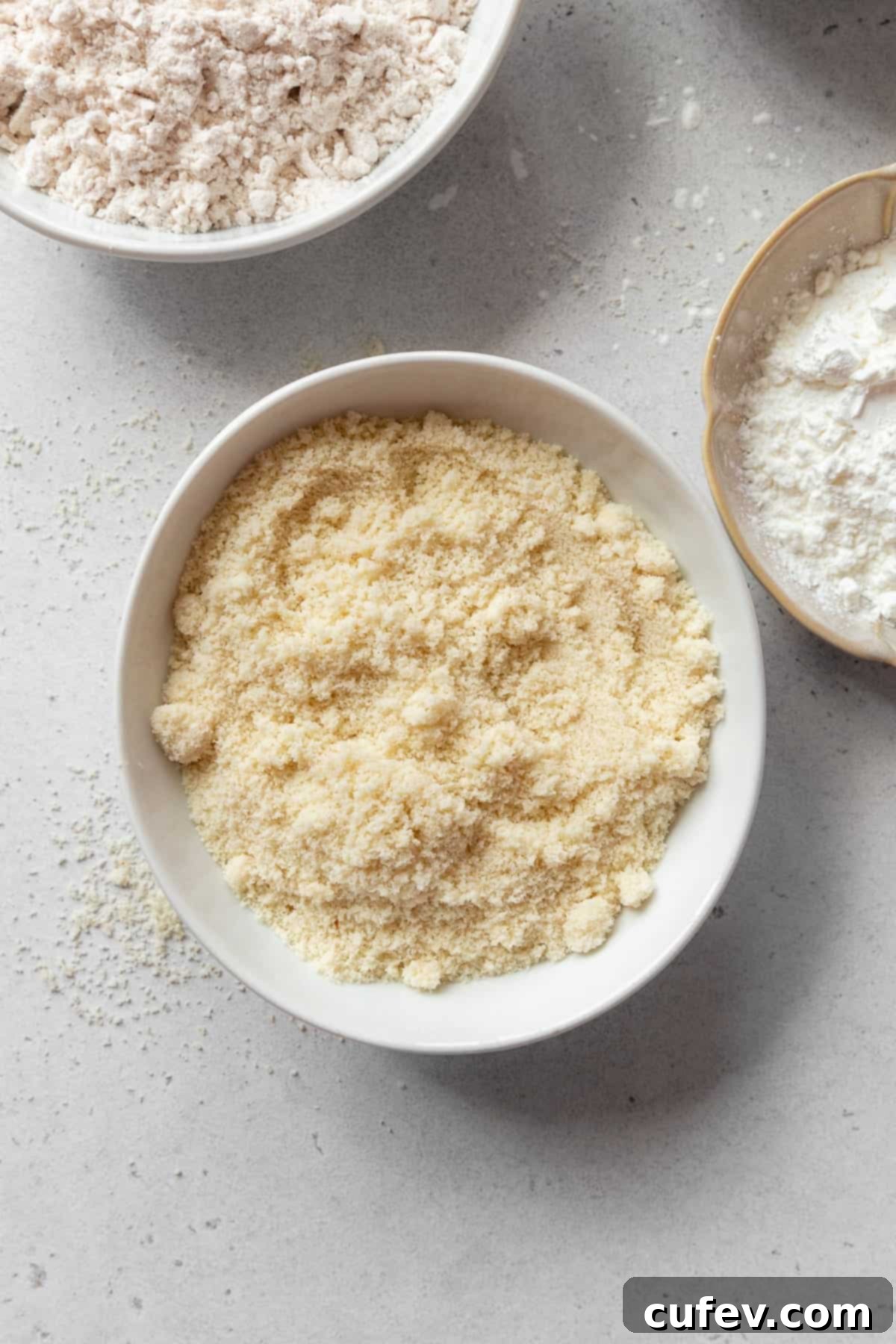
Oat Flour: Wholesome Texture and Mild Sweetness
Oat flour, essentially finely ground rolled oats, is a wonderfully wholesome and versatile gluten-free option. Its mild, slightly sweet flavor and ability to add softness and a delicate chewiness to baked goods make it a favorite for many. You can easily purchase it pre-packaged from various brands, or, for a more economical and customizable approach, make it yourself by grinding certified gluten-free rolled oats in a high-speed blender or food processor until a fine, powdery consistency is achieved.
One of the appealing qualities of oat flour is its contribution to a tender crumb and a pleasant, slightly rustic texture in recipes. It’s often used in muffins, quick breads, cookies, and pancakes. A notable advantage of oat flour is that, unlike some other flours, it generally doesn’t need to be heat-treated before consumption, making it perfect for no-bake treats. This is why I adore using it in my gluten-free edible cookie dough, allowing for safe and delicious indulgence straight from the bowl.
Important Note on Gluten-Free Oats: While oats themselves are naturally gluten-free, cross-contamination is a significant concern for individuals with celiac disease or severe gluten sensitivity. This occurs because many conventional oats are processed in facilities that also handle wheat, barley, or rye, or are grown in fields adjacent to gluten-containing grains. To ensure safety, it is absolutely critical to choose products that are explicitly labeled as “certified gluten-free oats” or “gluten-free oat flour.” These products have undergone stringent testing and processing protocols to meet specific gluten-free standards.
Oat flour also brings nutritional benefits, offering dietary fiber, protein, and various vitamins and minerals. It can absorb a good amount of liquid, which contributes to moist baked goods. However, because it can be quite absorbent, recipes specifically formulated for oat flour or careful adjustments when substituting are often necessary to prevent dry results. Store oat flour in an airtight container in a cool, dry place to maintain freshness, or in the refrigerator for extended shelf life.
Cornstarch and Potato Starch: The Secret to Lightness and Structure
Starches are indispensable in the gluten-free kitchen, serving dual roles in both cooking and baking. Cornstarch and potato starch are two of the most common and effective choices, prized for their thickening properties and their ability to impart a tender, light texture to baked goods. They act as a foundational component in many gluten-free flour blends and are often added individually to recipes to achieve specific desired qualities.
In cooking, I frequently rely on both cornstarch and potato starch to thicken sauces, gravies, soups, and stir-fries, providing a smooth, glossy finish without the cloudiness that flour might create. They activate quickly when heated, making them excellent last-minute thickeners.
For baking, starches are truly transformative. I particularly love incorporating cornstarch into cake batters to achieve an unparalleled tenderness and a wonderfully light, airy crumb. It helps to weaken the protein structure (even in gluten-free systems, some proteins exist) and absorb moisture, resulting in a softer final product. You’ll find it featured in almost all my cake recipes, from my decadent gluten-free chocolate cake and comforting gluten-free coffee cake, to my fluffy gluten-free blueberry muffin recipe, where it consistently elevates the texture.
Potato starch, while similar to cornstarch in its thickening power, can sometimes offer an even lighter texture in certain baked goods. Both are neutral in flavor, making them ideal additions that won’t interfere with the primary tastes of your recipe. When substituting one for the other, it’s generally a 1:1 ratio, though some bakers have a preference for one over the other in specific applications. Always measure starches carefully, as too much can lead to a gummy or pasty texture.
Another common gluten-free starch is tapioca starch (also known as tapioca flour). Derived from the cassava root, tapioca starch adds chewiness, crispness, and lightness. It’s often used in combination with rice flours to improve texture and elasticity, and is particularly good for creating a chewy crust on breads or a tender bite in cookies. It’s a fantastic alternative if you want to avoid corn or potato.
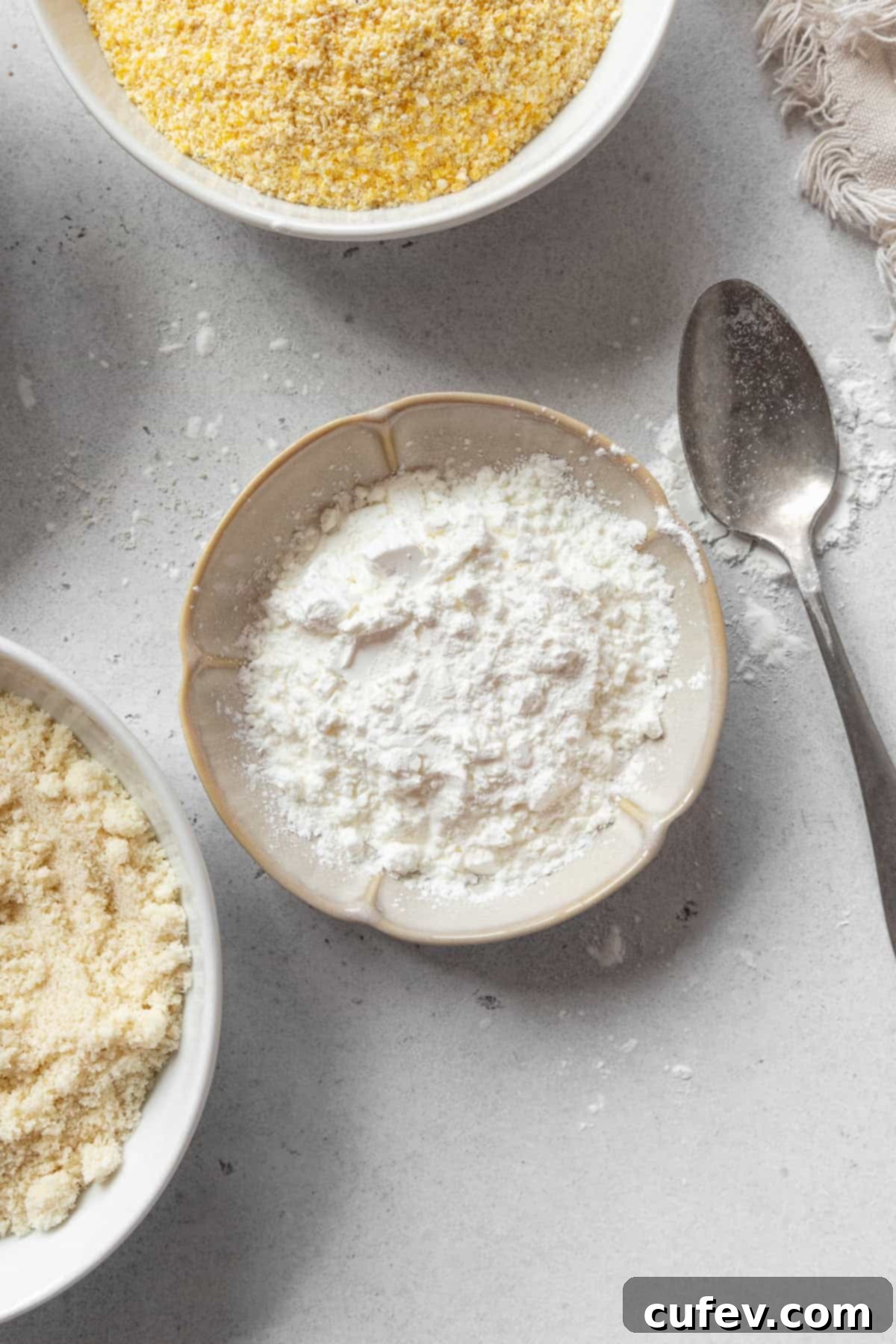
Rice Flours: The Cornerstone of Gluten-Free Baking
Rice flour, in its various forms, is undeniably a cornerstone of almost every gluten-free kitchen. Its versatility, neutral flavor profile, and fine texture make it an essential component in many gluten-free flour blends and a fantastic standalone option for specific recipes. I make sure to keep several types of rice flour stocked in my pantry, as each offers unique properties that can significantly impact the outcome of a dish.
White Rice Flour and Brown Rice Flour
The two most common types are white rice flour and brown rice flour. White rice flour is milled from polished white rice, resulting in a very fine, light powder with a neutral flavor. It’s excellent for delicate baked goods, thickening sauces, and making lighter pastries. Brown rice flour, on the other hand, is milled from whole grain brown rice, retaining the bran and germ. This gives it a slightly coarser texture, a nuttier flavor, and a higher nutritional content, including more fiber. It’s often used in whole-grain gluten-free blends or in recipes where a heartier texture and flavor are desired. When using brown rice flour, sometimes a bit more liquid is needed due to its higher absorbency.
Sweet Rice Flours: Mochiko, Joshinko, and Shiratamako
Beyond standard white and brown rice flours, there’s a fascinating category of “glutinous” rice flours. The term “glutinous” here refers to their sticky, chewy texture when cooked, not to the presence of gluten (they are completely gluten-free!). These flours are derived from sticky rice varieties and are particularly popular in Asian cuisine for their unique textural contributions.
- Mochiko: This is a fine and powdery sweet glutinous rice flour. It’s most famously used to make traditional Japanese mochi, but its applications extend far beyond. Adding mochiko to pancake and waffle batter, for example, can give them a delightful, fun chewy texture that’s unlike anything you’d achieve with other flours. It’s also excellent for thickening desserts and providing a tender, resilient bite.
- Joshinko: In contrast to mochiko, joshinko is a coarser rice flour, also made from non-glutinous short-grain rice. It provides a firmer, more resilient texture and is frequently used in traditional Japanese sweets, such as kashiwa mochi, where it contributes to a distinct, slightly chewy yet firm consistency.
- Shiratamako: This is another form of sweet glutinous rice flour, distinguished by its pregelatinized nature. Shiratamako is processed in a way that allows it to dissolve easily in water and produce a remarkably smooth, elastic, and chewy texture, making it the preferred choice for premium mochi and dango. I specifically use it in both my silky shiratama dango and exquisite ichigo daifuku recipes for its superior mouthfeel.
Rice Flour for Gluten-Free Bread Baking
Achieving the perfect loaf of gluten-free bread is often considered the holy grail of gluten-free baking, and rice flours play a crucial role in this endeavor. As I continue my experiments with gluten-free bread baking, I’ve discovered that specific rice flours can make an immense difference in texture, rise, and crust development. My personal favorite, after extensive testing, is a Japanese rice flour called mizuhochikara. Its unique protein and starch composition creates an incredibly soft crumb and satisfying chewiness, closely mimicking traditional wheat bread.
Unfortunately, mizuhochikara is not widely available outside of Japan, presenting a delightful challenge. I am actively testing various alternative rice flours and combinations to find a worthy substitute that delivers comparable results. Once I discover a readily accessible option that comes close to the performance of mizuhochikara, I will absolutely update this post to share my findings and recipe recommendations. Until then, standard white and brown rice flours remain key components in many successful gluten-free bread blends, often paired with starches and other whole-grain flours to build structure and flavor.

Cornmeal: Rustic Texture and Hearty Flavor
Cornmeal is a beloved gluten-free ingredient that brings a distinct rustic texture and an unmistakable sweet corn flavor to baked goods and savory dishes alike. Milled from dried corn, it’s available in various grinds – fine, medium, and coarse – each offering a different textural experience. I always ensure I have either medium or finely ground cornmeal in my pantry, as they are incredibly versatile for a wide range of recipes.
The texture of cornmeal adds a delightful grit and chewiness that is highly sought after in certain preparations. It’s a fantastic base for savory dishes like creamy grits, providing a comforting and hearty meal. In baking, cornmeal shines in recipes like fluffy pancakes or waffles, where it adds subtle texture and flavor. It’s also the essential ingredient for creating classic, crumbly gluten-free cornbread and even innovative uses such as savory cornbread croutons, adding a unique character that other flours simply cannot replicate.
Masarepa: The Foundation of Arepas and More
A specialized form of cornmeal, masarepa (also known as pre-cooked cornmeal flour), is a staple in Latin American cuisine, particularly in countries like Venezuela and Colombia. Unlike regular cornmeal, masarepa undergoes a unique process where the corn is soaked, cooked, dried, and then ground into a fine flour. This pre-cooking step makes it ideal for instant preparation and gives it distinct textural qualities.
Masarepa is most famously used to make traditional arepas – thick, savory corn cakes that are crispy on the outside and soft on the inside, often split and filled with various ingredients. I rely on the P.A.N. brand of masarepa to craft perfect arepas, which I then love to fill with delicious concoctions like reina pepiada (a creamy chicken and avocado salad). Its unique ability to form a dough that holds its shape and cooks beautifully makes it indispensable for these beloved dishes. Masarepa is also used for empanadas, pupusas, and other corn-based specialties.
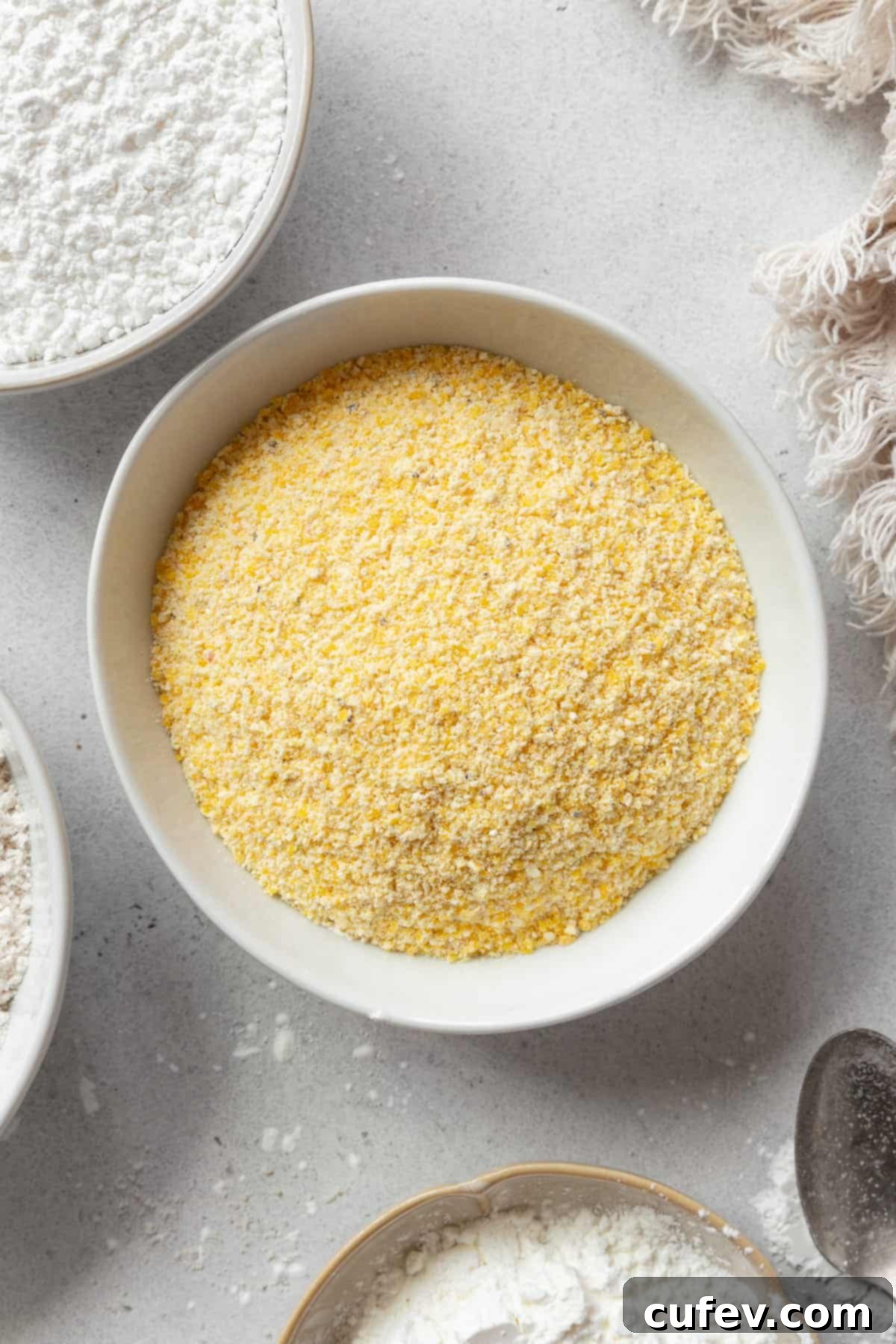
Other Essential Gluten-Free Flours and Starches
While we’ve covered many of the most popular gluten-free flours, the world of gluten-free baking is rich with other valuable ingredients that can elevate your culinary creations. Expanding your pantry to include these can open up even more possibilities for texture, flavor, and nutritional benefits.
Tapioca Flour/Starch
Tapioca flour, often interchangeably called tapioca starch, is extracted from the cassava root. It’s a fine, white powder that acts as an excellent thickening agent and binder in gluten-free baking. Tapioca starch is particularly valued for its ability to add chewiness and crispiness to baked goods, making it a common component in gluten-free flour blends. It’s fantastic for creating a desirable crust on breads, adding stretchiness to doughs, and contributing to the tender, slightly chewy texture of cookies and pancakes. When used in small amounts, it can also give a glossy finish to sauces and pies. It’s a great alternative to cornstarch or potato starch if you have sensitivities to those.
Sorghum Flour
Sorghum flour is a whole-grain, nutrient-dense flour made from the ancient grain sorghum. It boasts a mild, slightly sweet flavor and a smooth texture, making it a versatile ingredient in gluten-free baking. Sorghum flour adds a hearty, yet tender crumb to baked goods and can be used in a variety of recipes, including muffins, cookies, breads, and even cakes. Because it’s a whole grain, it also contributes valuable fiber and protein. It works well in combination with other gluten-free flours and starches to create a balanced texture and prevent dryness. It’s an excellent choice for adding a more robust, wholesome character to your gluten-free creations.
Cassava Flour
Also derived from the cassava root, cassava flour is different from tapioca starch because it’s made from the whole root, peeled, dried, and ground. This means it contains more fiber and behaves differently than pure starch. Cassava flour has a very fine texture and a mild, neutral flavor, making it a versatile 1-to-1 substitute for wheat flour in many recipes. It’s highly absorbent and can give a lovely soft and tender texture to baked goods. It’s particularly popular for grain-free and paleo baking, often used in tortillas, flatbreads, and certain types of cakes and cookies. Remember its high absorbency when baking and adjust liquids as needed.
Tips for Successful Gluten-Free Baking
Mastering gluten-free baking takes practice, but a few key strategies can significantly improve your results:
- Measure by Weight: Gluten-free flours vary greatly in density. Measuring by weight (grams) rather than volume (cups) provides far more accurate and consistent results.
- Use Xanthan Gum (if not in blend): As mentioned, this is crucial for elasticity and structure. Always check your blend’s ingredients or add it separately.
- Hydration is Key: Gluten-free flours can be very absorbent. Don’t be afraid to adjust liquid amounts slightly if your dough or batter seems too dry. Gluten-free doughs often benefit from being a bit wetter than their traditional counterparts.
- Rest Your Dough/Batter: Allowing gluten-free doughs and batters to rest for 15-30 minutes (or longer, depending on the recipe) can help the flours fully hydrate, leading to a better texture and less gritty result.
- Don’t Overmix: While gluten-free batters don’t develop gluten, overmixing can still create dense or tough results. Mix only until just combined.
- Cool Completely: Gluten-free baked goods can be fragile when warm. Let them cool completely before slicing or handling to allow their structure to set.
- Store Properly: Many gluten-free flours benefit from refrigeration or freezing to extend shelf life, especially those high in oils like almond flour or whole-grain options like brown rice flour.
With this expanded knowledge of gluten-free flours, you’re now well-equipped to tackle any baking challenge. From crafting delicate cakes with almond flour to hearty breads with rice flour blends, the possibilities are endless. Don’t be afraid to experiment with different combinations and discover your own favorite blends and recipes. Grab your chosen flours, embrace the adventure, and make something truly delicious!
Explore all of my tested and perfected gluten-free recipes here to put your new knowledge into practice and enjoy fantastic gluten-free meals and treats.
